 |
 |
 |
| |
Impact of Gender on Response to Lopinavir/ritonavir (LPV/r) Tablets Dosed QD or BID Administered with Tenofovir Disoproxil Fumarate (TDF) and Emtricitabine (FTC) in Antiretroviral-naive (ARV) Subjects: Results from Study M05-730
|
| |
| |
Reported by Jules Levin
XVII International AIDS Conference, 3-8 August 2008 • Mexico City
Barbara da Silva, Daniel Cohen, Sara Gibbs, Theresa Marsh, Danielle Grant, Jan Hairrell, Isabelle Gaultier, Linda Fredrick, Barry Bernstein. Abbott Laboratories, North Chicago, IL
AUTHOR SUMMARY
Despite higher baseline HIV-1 viral loads in males, LPV/r tablets dosed QD or BID had similar efficacy in antiretroviral-naive males and females.
Mean CD4+ T-cell increases were similar between males and females regardless of baseline CD4+ T-cell count, except that females with baseline CD4+ T-cell counts < 50 cells/mm3 tended to experience higher mean increases than males in the same baseline CD4+ T-cell count sub-group.
LPV/r was similarly well tolerated in males and females.
At baseline, females had lower TG and higher HDL cholesterol levels compared to males.
In general, mean increases in all lipid parameters were similar between genders, except for greater HDL increases among females compared to males (within QD, BID and overall). In addition, male subjects had a slightly greater mean increase in TG than females when dosed BID, and a higher proportion of males experienced Grade 3+ triglyceride elevations, which may have been due to a tendency for higher baseline triglyceride levels. It is likely that these differences are not clinically significant, since both genders had similarly small decreases in LDL:HDL ratio.
Both male and female subjects overwhelmingly preferred the tablet formulation over the SGC. The reasons associated with patient preference were not collected, but may include the lack of refrigeration, diminished food effect, and possible tolerability effects not detected by the standardized adverse event assessment performed during a clinical trial. Data from this study are consistent with previous studies5-7 that demonstrated patient preference for the tablet formulation after switching from the SGC.
AUTHOR CONCLUSIONS
A LPV/r-based regimen dosed QD or BID provides similar efficacy, regardless of baseline viral load or CD4+ T-cell count and similar immunologic recovery, regardless of baseline CD4+ T-cell count, in both males and females.
LPV/r QD and BID are similarly well tolerated in men and women.
Higher baseline TG values for men may contribute to a slightly higher proportion of men with Grade 3+ TG abnormalities through 48 weeks while receiving LPV/r QD or BID.
The patient preference questionnaire demonstrated that male and female subjects, who switched to the tablet formulation at Week 8, overwhelmingly preferred the tablet formulation over the SGC.
BACKGROUND
The number of women diagnosed with HIV infection and AIDS has significantly increased over the course of the epidemic.
By the end of 2007, according to the World Health Organization (WHO), 15.4 million women worldwide were infected with HIV.1
According to the Centers for Disease Control and Prevention (CDC), in the period between 2000 through 2004, women represented 29% of the estimated number of AIDS cases in the United States. The number of AIDS cases increased by 10% in women and 7% in men. HIV infection disproportionately affects African-American and Hispanic women. Together they represent less than 25% of all U.S. women, yet they account for more than 79% of AIDS cases in women.2
Limited information is available regarding the impact of gender on the safety and efficacy of antiretroviral agents. Virologic and immunologic status at time of clinical presentation as well as response to combination antiretroviral therapy may vary between men and women.3
OBJECTIVE
The objective of this analysis is to compare and assess differences in virologic response, CD4+ T-cell counts, therapy preference, and safety, based on adverse events (AEs), laboratory abnormalities and changes from baseline Ñ between male and female subjects through 48 weeks in Study M05-730.
The M05-730 study design is shown in Figure 1.
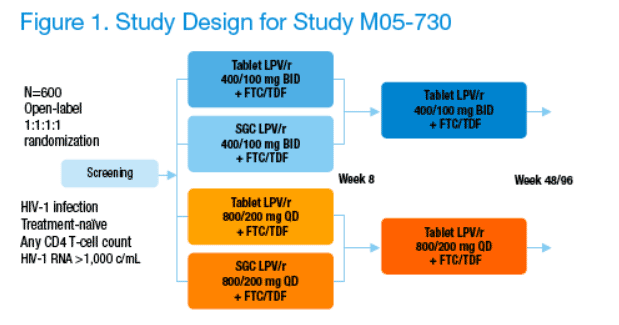
METHODS
Study M05-730 is an ongoing 96-week Phase 3, open-label, randomized, multi-center, multi-country study that enrolled antiretroviral (ARV)-naive subjects
with HIV-1 RNA ≥ 1000 copies/mL and any CD4+ T-cell count.
664 ARV-naive HIV-1 infected subjects were dosed after being randomized 1:1:1:1 to LPV/r QD SGC, BID SGC, QD tablet, or BID tablet for 8 weeks.
• All subjects received emtricitabine (FTC) 200 mg QD and tenofovir disoproxil fumarate (TDF) 300 mg QD.
At Week 8, all subjects receiving LPV/r SGC were switched to the tablet formulation while maintaining their same randomized dosing schedule (QD vs. BID).
Subjects were evaluated every 2 weeks through Week 16, every 8 weeks through Week 48, then every 12 weeks through Week 96.
Efficacy Analyses
-- Primary efficacy endpoint: Proportion of subjects with HIV-1 RNA <50 copies/mL at Week 48, using an intent-to-treat, noncompleter=failure (ITT, NC=F) approach comparing QD and BID groups. The pre-specified non-inferiority margin was 12%.
-- Secondary analyses included the mean change from baseline in CD4+ T-cell count and the emergence of viral resistance through 48 weeks.
48-week safety and efficacy were compared between male and female subjects, with respect to virologic response, CD4+ T-cell increase from baseline, adverse events (AEs) and laboratory abnormalities.
Therapy preference was assessed for subjects who switched from the SGC to tablet formulation at Week 8. Subjects were asked to choose which formulation they preferred: Kaletra Tablets, Kaletra Soft Gel Capsules, or equal preference for Kaletra Tablets and Soft Gel Capsules.
RESULTS
664 ARV-naive HIV-1 infected subjects were randomized and dosed.
Overall, in the M05-730 primary efficacy analysis at Week 48, 77% of QD-treated and 76% of BID-treated subjects achieved a viral load <50 copies/mL by ITT, NC=F analysis.4
The difference in response rates (QD minus BID) and 95% CI was 1% (-5% to 8%), which confirmed the non-inferiority of the QD regimen to the BID regimen, as the lower bound of the confidence interval was within the pre-specified margin of -12%. The on-treatment data confirmed this finding.4
Overall, similar mean increases from baseline in CD4+ T-cell count at Week 48 were observed in the QD and BID treatment groups (186 and 197 cells/mm3, respectively; p=0.350).4
Baseline characteristics for this analysis are shown in Table 1, comparing female vs. male subjects, in the BID and QD arms.
Overall, males had slightly higher HIV-1 RNA levels compared to females (p=0.004). The proportion of subjects with baseline HIV-1 RNA < 5 log10
copies/mL was higher in females than in male subjects (p=0.014, p=0.047, and p=0.002 for QD, BID and overall, respectively).
Females had lower baseline TG (p<0.001) and higher baseline HDL cholesterol (p<0.001) compared to males.
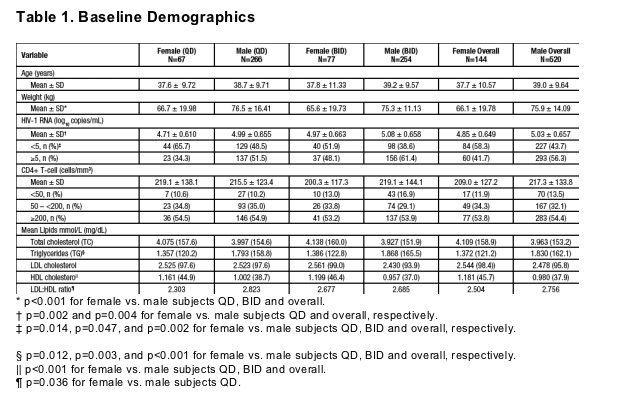
Table 2 shows subject disposition by gender and dosing group.
Overall, the proportion of subjects who discontinued the study due to being lost to follow-up was statistically significantly greater for the female subjects (7.6%) compared to the male subjects (3.1%), p=0.028.

Efficacy
Overall, 78% males and 72% females achieved HIV-1 RNA <50 copies/mL at Week 48, p=0.120 (Figure 2a).
There was no statistically significant difference in virologic response at Week 48 between male and female subjects within either dosing group (Figure 2b), or regardless of baseline CD4+ T-cell count or baseline viral load (Figures 3a-b).
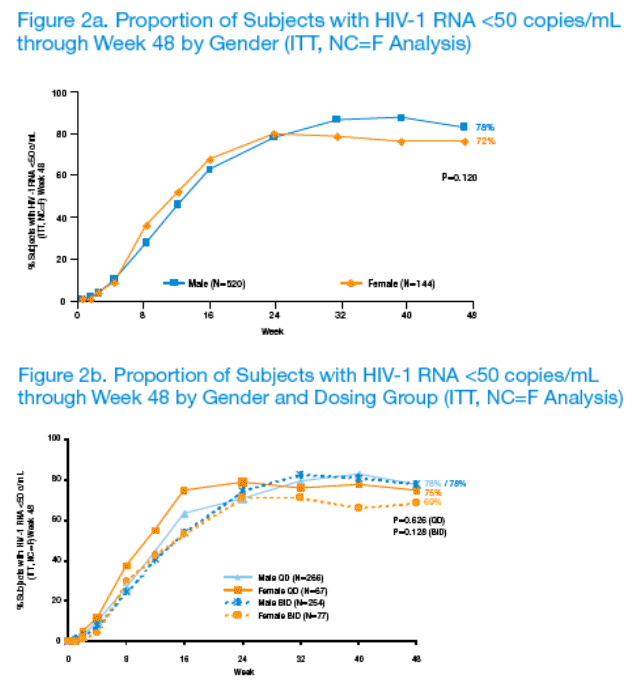
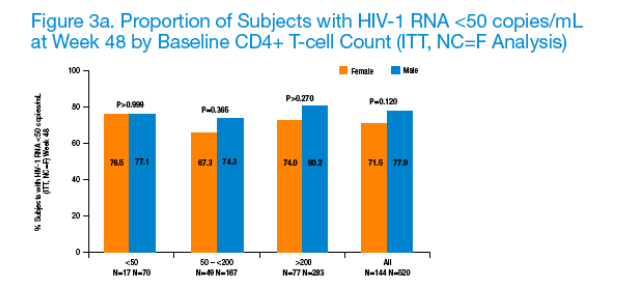
There was no difference in immunologic recovery at Week 48 between males and females. Overall, mean CD4+ T-cell increase from baseline was 189 cells/mm3 for males, and 204 cells/mm3 for females, p=0.298 (Figure 4).
A significant difference in the mean CD4+ T-cell increase was observed between males and females with baseline CD4 counts <50 cells/mm3: +167 vs. +237 cells/mm3, respectively (p=0.007). In the three other baseline CD4 subgroups, mean increases in CD4+ T-cell counts were similar between males and females.
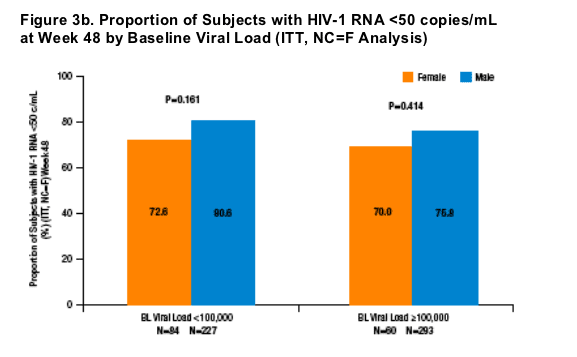
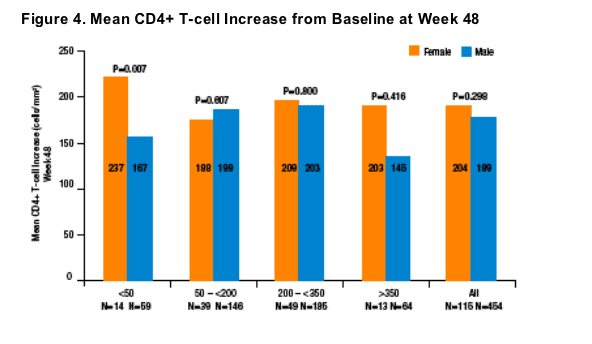
Safety
The only study drug-related AEs of moderate to severe nature (≥5.0% in any gender/dose group) were diarrhea, nausea and vomiting. All occurred with similar frequency between male and female subjects within and across dose groups (Table 3).
The overall rate of moderate to severe drug-related AE of diarrhea for the study was 15.8%. The rate for males was 17.1%, vs. 11.1% for females, p=0.093.
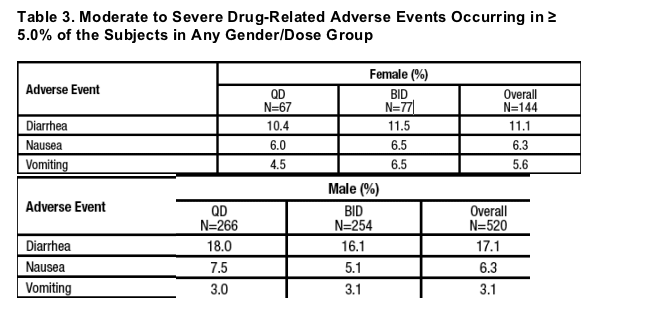
Greater mean increases in triglycerides were noted in male subjects dosed BID (p=0.026) compared to female subjects dosed BID (Table 4).
Greater mean increases were noted in HDL for females compared to males (p=0.047 QD and p=0.041 overall).
Mean increases were similar between male and female subjects for all other lipid parameters.
Mean decreases in LDL:HDL ratio through 48 weeks were similar between females and males.
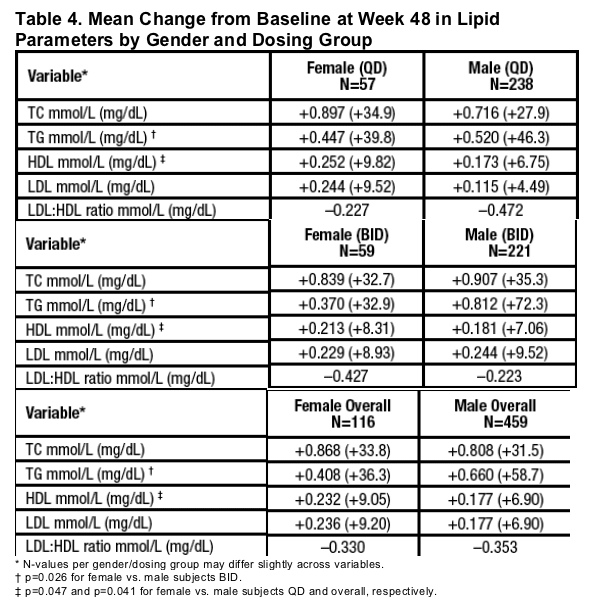
Grade 3+ triglyceride elevations were noted in 1% of females vs. 6% of males, p=0.011 (Table 5); however, males had higher mean baseline triglyceride values
than females (162.1 mg/dL (1.83 mmol/L) vs. 121.2 mg/dL (1.37 mmol/L), p< 0.001).
At Week 48, there were no significant differences between gender groups in terms of Grade 3/4 elevations in transaminases, total cholesterol, and creatinine clearance, regardless of dosing regimen.
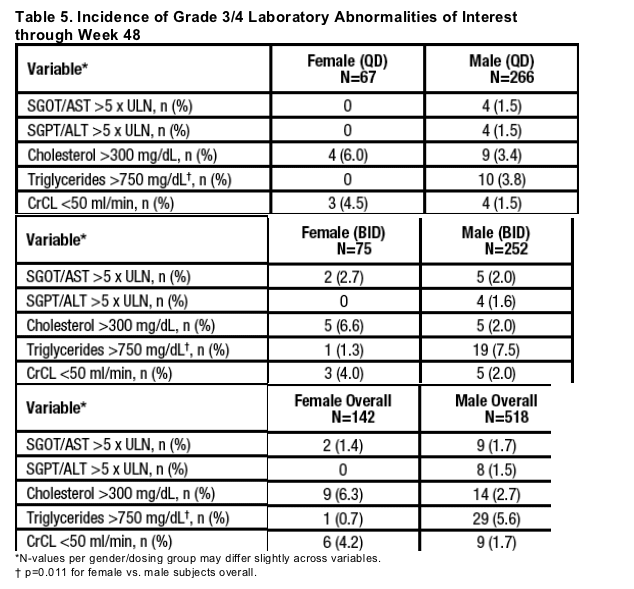
PATIENT PREFERENCE
The patient preference questionnaire administered at Week 12 demonstrated that both male and female subjects who switched from the LPV/r soft gel capsule (SGC) to the tablet formulation at Week 8 overwhelmingly preferred the tablet formulation (Figure 5).
Of those subjects who switched from the SGC to the tablet formulation at Week 8, 75% of females and 78% of males preferred the tablet over the SGC (p<0.001 for both). Only 5% of female subjects and 4% of male subjects preferred the SGC over the tablet.
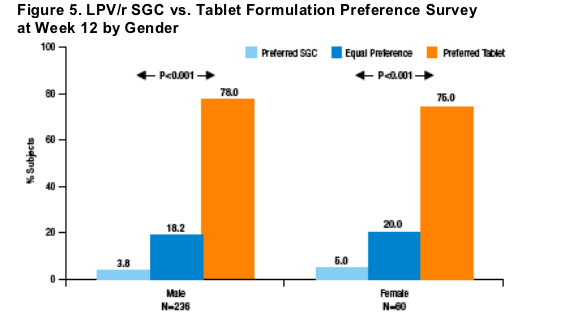
References
1. UNAIDS - WHO. 07 AIDS Epidemic Update, December 2007
2. US Centers for Disease Control and Prevention. MMWR June 2, 2006 55(21);589-592
3. Anastos K, Gange SJ, Lau B, Weiser B, Detels R, Giorgi J, et al. Association of race and gender with HIV-1 RNA levels and immunologic progression. JAIDS. 2000;24:218-226
4. Gathe J, da Silva BA, Loutfy M, et al. Study M05-730 Primary Efficacy Results at Week 48: Phase 3, randomized, open-label study of lopinavir/ritonavir (LPV/r) tablets once daily (QD) versus twice daily (BID), co-administered with tenofovir DF (TDF) + emtricitabine (FTC) in antiretroviral-naive (ARV) HIV-1 infected subjects. 15th Conference on Retroviruses and Opportunistic Infections (CROI), Boston, USA
5. Ofotokun I, Chuck SK, Rivas M, et al. Switching from lopinavir/ritonavir (LPV/r) soft gel capsule (SGC) to tablet formulation improves tolerability in indigent AIDS clinic. 45th Annual Meeting of the Infectious Disease Society of America, San Diego, USA 2007. Abstract #962
6. Schrader S, Chuck SK, Rahn LW, et al. Switching to lopinavir/ritonavir (LPV/r) tablets once daily (TAB-QD) from soft-gel capsule dosed BID/QD (SGC-BID/SGC-QD) led to significant improvements in tolerability, diarrhea, anti-diarrheal medication use, and satisfaction. 8th International Workshop on Adverse Drug Reactions and Lipodystrophy in HIV, San Francisco, USA 2006. Abstract #83
7. Schrader S, Chuck SK, Rahn LW, et al. Significant improvements in self-reported gastrointestinal tolerability, quality of life (QoL), patient satisfaction, and adherence with lopinavir/ritonavir (LPV/r) after switching from BID soft-gel capsule (SGC) to BID tablets. 8th International Workshop on Adverse Drug Reactions and Lipodystrophy in HIV, San Francisco, USA 2006. Abstract #81
|
| |
|
 |
 |
|
|